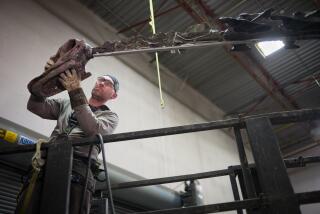Montana Museum Finally Wins Big Prize : Dinosaurs: After years of losing fossils to others, a treasured Tyrannosaurus Rex skeleton will stay in the state. The bones excite experts and tourists.
- Share via
BOZEMAN, Mont. — Strangers have forever been coming to dig precious things out of Montana’s ancient dirt--sapphires, copper, fossils--digging them up and carting them away.
Not this time. This time the home team won. The trophy stays put. A museum right here, with exhibits that can run to barbed wire, frontier fashions and Rocky Mountain stargazing, has pulled off the grand slam, the Triple Crown, the Academy Award of saurian paleontology: the biggest, most complete Tyrannosaurus Rex skeleton ever found.
It is a handsome textbook specimen, and “just about everybody would like to have it,” Museum of the Rockies project coordinator Pat Leiggi said primly. “But it’s ours.”
Kathy and Tom Wankel are the Montana ranching couple who turned up the skeleton on a bone-hunting outing in the Montana badlands some time back, unearthing a bit with a garden shovel and a jackknife. The first complete bone Kathy Wankel ever found turned out to be the first complete T-Rex arm anyone had ever found.
When they somewhat diffidently drove it over to the Museum of the Rockies at Montana State University and found out what it was, “we wanted it to stay here,” Kathy Wankel said.
“I think it’s kind of a sore spot that all these out-of-staters come and take the bones out and we get nothing for it,” she said. “I’m a true Montanan. And we need some nice, clean tourist industry.”
Montana is a perfect boneyard of dinosaurs. Wherever else they lived, this was an excellent place for them to die, preserved in 65-million-years worth of clay soil. For decades, fossils have been dug up and carried off to big-name, big-bucks institutions. Six of the seven T-Rex skeletons ever found were found in Montana. This one, which the Wankel boys call Mr. T, is the first to stay.
Leiggi doesn’t begrudge that. In the past, no local institution could handle fossils the way the big out-of-state bone boys could. “For other museums and programs to take things out of the state seemed perfectly justified,” Leiggi said. “But now we’re part of this network,” and “people are proud of the fact that not only is the dinosaur recognized as being from Montana but is staying in Montana.”
The paleontology department has gone from zero to bingo in a handful of years, thanks to renowned paleontologist John Horner, a Montana native who years ago went off to Princeton to work. He came back home to dig, but whatever treasures he found he took away with him. When some fellow Montanans called him a “grave robber,” Leiggi says Horner answered: ‘ “When there’s a job for me to come home to, I’ll come back.’ ”
In 1982, he did, creating the first true paleontology department in the state. Horner’s groundbreaking work in baby dinosaurs, in habitat and in nesting behavior, has helped to forge a world-class department. “There isn’t anybody producing anything about dinosaurs who isn’t calling us,” Leiggi said.
Yet for all its reputation among peers, the Museum of the Rockies does not exactly top the nation’s vacation itineraries, like the Smithsonian.
Ah, but wait. T-Rex was not even out of the ground and the public was wild to see this screaming tabloid of a dinosaur, the big megilla, with teeth like daggers and an appetite like a sawmill. It’s like Leiggi says: You turn up a new duckbill, discover a colony of maiasaurs, and people say, that’s nice. “The Wankels find a T-Rex, and the world gets excited overnight.”
Overnight excitement takes time to satisfy. Leiggi will soon set up shop in the dinosaur hall, cleaning the T-Rex layer by layer in public view. Already they have learned much from this skeleton, nearly twice as complete as any other ever found.
The arm upended common wisdom that the T-Rex’s arms, the size of a man’s, were vestigial at best. Project worker Matt Smith has studied its biomechanics and found that size is not necessarily function; those scrawny little arms, arms the T-Rex couldn’t even see, could hang onto more than 400 pounds, 10 times what a man’s can.
The plaster and burlap-wrapped pieces arrived July 3 after 28 days of digging at a secret site. Even then word had leaked, and dinosaur buffs were begging to help excavate. “It’s just me and my kid,” they would plead, “and he’s a good kid.”
Not a chance. The skeleton lay in an old stream bed, its back arched in rigor mortis. The team had to dig the bones free in separate blocks, like vast chunks of peat, tunneling and squirming beneath them to make sure they’d gotten everything.
Hoisting the 6,500-pound pelvic block had everybody sweating. Had it fallen, someone working beneath it would have been killed, Leiggi said.
And forget what the science-fiction movies show. In all of Earth’s history, it would have been the only human being to be killed by a Tyrannosaurus Rex.
More to Read
Sign up for Essential California
The most important California stories and recommendations in your inbox every morning.
You may occasionally receive promotional content from the Los Angeles Times.














